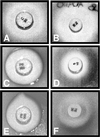Stress responses as a tool To detect and characterize the mode of action of antibacterial agents
- PMID: 10543818
- PMCID: PMC91676
- DOI: 10.1128/AEM.65.11.5023-5027.1999
Stress responses as a tool To detect and characterize the mode of action of antibacterial agents
Abstract
Single-copy gene fusions between the lacZ reporter gene and Escherichia coli strains containing promoters induced by cold shock (cspA), cytoplasmic stress (ibp), or protein misfolding in the cell envelope (P3rpoH) were constructed and tested to determine their ability to detect antibacterial agents while simultaneously providing information on their cellular targets. Antibiotics that affect prokaryotic ribosomes selectively induced the cspA::lacZ or ibp::lacZ gene fusion, depending on their mode of action. The membrane-damaging peptide polymyxin B induced both the P3rpoH::lacZ and ibp::lacZ fusions, while the beta-lactam antibacterial agent carbenicillin activated only the P3rpoH promoter. Nalidixic acid, a compound that causes DNA damage, downregulated beta-galactosidase synthesis from P3rpoH but had little effect on expression of the reporter enzyme from either the cspA or ibp promoter. All model antibiotics could be identified over a wide range of sublethal concentrations with signal-to-noise ratios between 2 and 11. A blue halo assay was developed to rapidly characterize the modes of action of antibacterial agents by visual inspection, and this assay was used to detect chloramphenicol secreted into the growth medium of Streptomyces venezuelae cultures. This simple system holds promise for screening natural or combinatorial libraries of antimicrobial compounds.
Figures



Similar articles
-
Hyperosmotic shock induces the sigma32 and sigmaE stress regulons of Escherichia coli.Mol Microbiol. 1999 Dec;34(5):1029-38. doi: 10.1046/j.1365-2958.1999.01664.x. Mol Microbiol. 1999. PMID: 10594827
-
Stress-based identification and classification of antibacterial agents: second-generation Escherichia coli reporter strains and optimization of detection.Antimicrob Agents Chemother. 2002 Aug;46(8):2490-7. doi: 10.1128/AAC.46.8.2490-2497.2002. Antimicrob Agents Chemother. 2002. PMID: 12121923 Free PMC article.
-
CspI, the ninth member of the CspA family of Escherichia coli, is induced upon cold shock.J Bacteriol. 1999 Mar;181(5):1603-9. doi: 10.1128/JB.181.5.1603-1609.1999. J Bacteriol. 1999. PMID: 10049393 Free PMC article.
-
The cold-shock response--a hot topic.Mol Microbiol. 1994 Mar;11(5):811-8. doi: 10.1111/j.1365-2958.1994.tb00359.x. Mol Microbiol. 1994. PMID: 8022259 Review.
-
Modes of action of antimicrobial agents.Top Curr Chem. 1977;72:1-19. doi: 10.1007/BFb0048447. Top Curr Chem. 1977. PMID: 202040 Review. No abstract available.
Cited by
-
Global transcriptional response of Bacillus subtilis to treatment with subinhibitory concentrations of antibiotics that inhibit protein synthesis.Antimicrob Agents Chemother. 2005 May;49(5):1915-26. doi: 10.1128/AAC.49.5.1915-1926.2005. Antimicrob Agents Chemother. 2005. PMID: 15855514 Free PMC article.
-
Sorting Out Antibiotics' Mechanisms of Action: a Double Fluorescent Protein Reporter for High-Throughput Screening of Ribosome and DNA Biosynthesis Inhibitors.Antimicrob Agents Chemother. 2016 Nov 21;60(12):7481-7489. doi: 10.1128/AAC.02117-16. Print 2016 Dec. Antimicrob Agents Chemother. 2016. PMID: 27736765 Free PMC article.
-
Techniques for Screening Translation Inhibitors.Antibiotics (Basel). 2016 Jun 24;5(3):22. doi: 10.3390/antibiotics5030022. Antibiotics (Basel). 2016. PMID: 27348012 Free PMC article. Review.
-
Bacterial toxicity of potassium tellurite: unveiling an ancient enigma.PLoS One. 2007 Feb 14;2(2):e211. doi: 10.1371/journal.pone.0000211. PLoS One. 2007. PMID: 17299591 Free PMC article.
-
Attenuation-based dual-fluorescent-protein reporter for screening translation inhibitors.Antimicrob Agents Chemother. 2012 Apr;56(4):1774-83. doi: 10.1128/AAC.05395-11. Epub 2012 Jan 17. Antimicrob Agents Chemother. 2012. PMID: 22252829 Free PMC article.
References
-
- Belkin S, Smulski D R, Dadon S, Vollmer A C, Van Dyk T K, LaRossa R A. A panel of stress-responsive luminous bacteria for the detection of selected classes of toxicants. Water Res. 1997;31:3009–3016.
-
- Belkin S, Van Dyk T K, Vollmer A C, Smulski D R, LaRossa R A. Monitoring subtoxic environmental hazards by stress-responsive luminous bacteria. Environ Toxicol Water Qual. 1996;11:179–185.
Publication types
MeSH terms
Substances
LinkOut - more resources
Full Text Sources
Other Literature Sources
Medical

